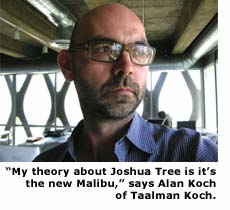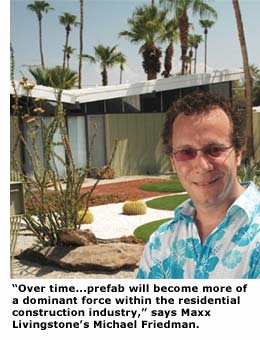Prefabulous or Fad? - Page 3
Supplying what architects of the '50s and '60s called 'social housing'—low-cost houses for workers or homeless people—may not be the primary goal of the new prefabbers. But it is something that many hope to accomplish once production gears up. Instead, most architects' social concerns involve protecting the environment.

Prefab houses are kinder to the earth in part because they are smaller than conventional houses. "There are people who are attracted to the Mini-Cooper instead of the minivan," Koch says of his potential customers. "They are looking for something small and smart."
There is also much less waste manufacturing homes in a factory than on site, Kaufmann says. And most prefab designers promise to site their houses to reduce energy use, and use sustainable materials and non-toxic paints, and many outfit their homes with solar panels. Wind turbines are an option on Kaufmann's designs; they are especially useful for housing in remote spots that are off the electrical grid—including the monastery.
Buyers include people who are committed to living easy on the earth, says Steve Glenn, the founder of LivingHomes. "I think there is a big chunk of people who care deeply about design and who care deeply about the health and sustainability of the products they buy, but currently buy homes that don't really reflect those values unless they have the time, money, and stress tolerance to do it themselves," Glenn says. "These houses fit people who love design and who love health and sustainability," he says. "The group could be called the cultural creatives, the conscientious capitalists." Buyers are also people who would like a custom home, without the custom-home hassles or costs, he says.
Not surprisingly, the new prefabbers are going after artists and those with an artistic sensibility. That's one reason Joshua Tree, a growing artists colony in the high desert east of Palm Springs, is home to several new prefab homes, with many more on the way, including houses that Bryant Yeh (of Yeh + Jerrard) and Alan Koch and Linda Taalman (of Taalman Koch Architecture) are building for their own use and to use as showpieces. Maxx Livingstone also plans to build Krisel prefabs in Joshua Tree, and Marmol Radziner has clients in town as well.

Taalman Koch, whose biggest project was an art gallery, Dia Beacon in upstate New York, exemplifies the architect-artist connection that underlies much of the revived interest in prefab. The firm has collaborated with a number of artists on art project 'houses,' including Chris Burden's ten-foot high 'Beehive Bunker' made of premixed cement bags. For its iT house, a striking, aluminum-framed box that is almost entirely glass, a degree of privacy and a whole lot of art are provided by patterned, one-of-a-kind, artist-designed vinyl film (what Taalman Koch calls 'outFITs') that attaches to the glass.
One of their collaborating artists is Jim Isermann, who lives in an all-steel house in Palm Springs designed by Donald Wexler. "The owners are art collectors, and they got interested in the iT house because they wanted to collect some of his work," Koch says of his clients for the Isermann-decorated home. "They see the house as living artwork."
But it's not just the art-centric who are potential customers. Kaufman says she and her husband got into prefab when they couldn't find an affordable home in the Bay Area. Bryant Yeh and his wife are facing a similar affordability gap in Southern California. "Housing prices are spiraling out of control," he says, "so architects are looking at prefab."
Many of the new prefab homes are being built on small, urban infill lots, or in the hinterlands where land is relatively affordable. That explains the attraction of Joshua Tree. It's close enough to Los Angeles and San Diego, far less expensive than Palm Springs, and artistically cutting edge. "My theory about Joshua Tree is it's the new Malibu," Koch says. "It sounds like a crazy statement, but if you think about what Malibu was 60 years ago, it was the frontier, people had little beach shacks."
Modular homes can be cost-effective in remote areas, like Joshua Tree, where the price of labor drives up the cost of conventional construction. But as prefab grows more popular, driving costs down, it will be able to compete everywhere, proponents say. "We believe currently that prefab homes are best suited in areas where building traditionally may not be feasible," says Michael Friedman of Maxx Livingstone. "Over time we think this will change and prefab will become more of a dominant force within the residential construction industry."




